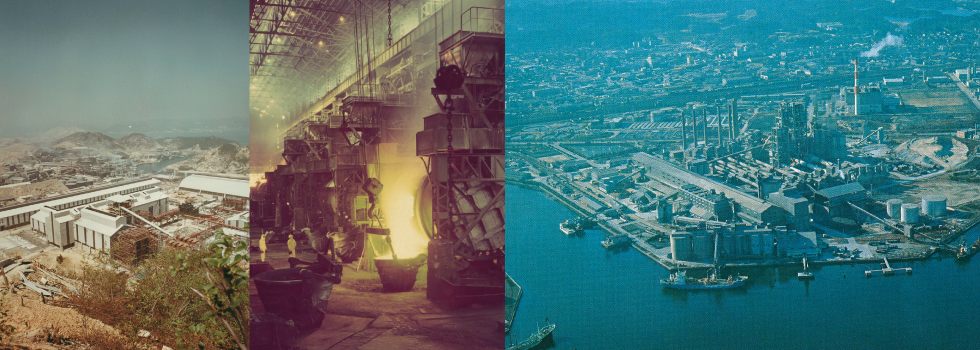![]() For steels
For steels
![]() For stainless steels
For stainless steels
![]() For cast iron
For cast iron
![]() For non-ferrous metal
For non-ferrous metal
![]() For difficult to cut material
For difficult to cut material
![]() For hardened material
For hardened material
Supporting the growth of the Mitsubishi Group

On April 1, 2017, Mitsubishi Materials introduced a new company logo featuring three red diamonds. This logo represents the Mitsubishi Materials Group’s emphasis on expanding overseas markets with its technological capabilities and facilitating further global business expansion. This feature focuses on the history of Mitsubishi Materials Corporation, a history of support for Mitsubishi Group business expansion.
In 1870, Yataro Iwasaki, an official of the Tosa Domain, established Tsukumo Shokai, a shipping company approved by the domain. This was the beginning of Mitsubishi. In 1873, the company name was changed to Mitsubishi Shokai. Yataro wrote a letter to his brother Yanosuuke telling him, “I changed the name of the company from Tsukumo Shokai to Mitsubishi Shokai. The company logo is ![]() .” This was the beginning of the logo that has become synonymous with reliability. The root of this logo was three diamonds adorning the flag flown on Tsukumo Shokai ships. It is believed that this logo integrated the three layers of diamonds on the Iwasaki Family crest, and the three oak leaves of the crest of the Yamauchi Family, whose head was lord of the Tosa Domain.
.” This was the beginning of the logo that has become synonymous with reliability. The root of this logo was three diamonds adorning the flag flown on Tsukumo Shokai ships. It is believed that this logo integrated the three layers of diamonds on the Iwasaki Family crest, and the three oak leaves of the crest of the Yamauchi Family, whose head was lord of the Tosa Domain.
In the same year, Yataro expanded the mining business, purchased Yoshioka Mine and started a metal refining business. Thus, as well as its original shipping business, coal and mineral mining became a major pillar of the business. These would become the foundation of Mitsubishi Materials Corporation.

In 1908, Mitsubishi Shokai implemented a divisional system for its mining, banking and shipbuilding businesses in which each business employed an independent, self-supporting accounting system. The implementation of this system for individual businesses managed by a head office was a very advanced approach in the Meiji Period (1868-1912). In addition, Mitsubishi established subsidiaries to enter a wide range of business fields. These became independent in the Taisho Period (1912-1926) and went on to be major members of Mitsubishi Kinyokai’s group of 28 companies.
In line with these developments, Mitsubishi Mining Co., Ltd. was established in 1918 to take over the Coal and Mineral Mining Division from Mitsubishi and the assets of the Mining Research Institute, which handled the mining business. This new company was the predecessor of Mitsubishi Materials Corporation. Mitsubishi Mining entered the cutting tool business in 1942 and in 1944, it started the mass production of powdered metallurgy products. Additionally in 1945 it started production of special copper alloys. These aggressive business expansions became the foundation for the current Mitsubishi Materials.

Mitsubishi Mining Co., Ltd. encountered hardship in 1947, two years after the end of the World War II. Under the influence of the American occupation policy, the Excessive Economic Power Deconcentration Act was established to dissolve large financial combines and Mitsubishi Mining became a target. Mitsubishi Mining at that time had capital funds of 407.4 million yen and annual sales of 4,400 million yen across 46 facilities, including 17 coal mines, 20 metal mines, and 9 other facilities such as smelters, and 69,672 employees.
On April 1, 1950, the Mitsubishi Mining Metal Division separated to establish Taihei Mining Co., Ltd. It was a painful division for the company; however, both Mitsubishi Mining and Taihei Mining continued growing under independent management. Mitsubishi Mining merged with Mitsubishi Cement Corporation and Hokoku Cement to establish Mitsubishi Mining & Cement Co., Ltd. in 1973. Taihei Mining’s name was changed to Mitsubishi Metal Mining Co., Ltd. in 1952, and changed again to Mitsubishi Metal Corporation in 1973 to start the new phase of its business.
On December 1, 1990, Mitsubishi Metal and Mitsubishi Mining & Cement merged into Mitsubishi Materials Corporation. Forty years after Mitsubishi Mining’s Coal and Metal Divisions were separated in 1950, the companies merged into one company. This merger resulted in the solid establishment of Mitsubishi Materials’ position as a comprehensive material manufacturer holding technology and products in a wide range of fields, including smelting, cement, cutting tools, alloys, ceramics, chemicals, silicon, fuels, building materials and nuclear power.
Inheriting the assets, technology and spirit of mining, Mitsubishi’s major business, Mitsubishi Materials has expanded its business aggressively. With its corporate philosophy “For People, Society and the Earth,” Mitsubishi Materials continues to protect its assets and traditions, creating new materials for people, society and the Earth with its unique technology and aims to be a leader in the establishment of a sound material-cycle society.
